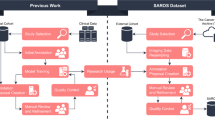Abstract
Aim
Automatic CT dataset classification is important to efficiently create reliable database annotations, especially when large collections of scans must be analyzed.
Method
An automated segmentation and labeling algorithm was developed based on a fast patient segmentation and extraction of statistical density class features from the CT data. The method also delivers classifications of image noise level and patient size. The approach is based on image information only and uses an approximate patient contour detection and statistical features of the density distribution. These are obtained from a slice-wise analysis of the areas filled by various materials related to certain density classes and the spatial spread of each class. The resulting families of curves are subsequently classified using rules derived from knowledge about features of the human anatomy.
Results
The method was successfully applied to more than 5,000 CT datasets. Evaluation was performed via expert visual inspection of screenshots showing classification results and detected characteristic positions along the main body axis. Accuracy per body region was very satisfactory in the trunk (lung/liver >99.5% detection rate, presence of abdomen >97% or pelvis >95.8%) improvements are required for zoomed scans.
Conclusion
The method performed very reliably. A test on 1,860 CT datasets collected from an oncological trial showed that the method is feasible, efficient, and is promising as an automated tool for image post-processing.
Similar content being viewed by others
References
Greenspan H, Goldberger J, Ridel L (2001) A Continuous probabilistic framework for image matching. J Comput Vis Image Underst 84(3): 384–406
Pinhas A, Greenspan H (2004) A continuous and probabilistic framework for medical image representation and categorization. In: Proceedings of SPIE, vol 5371, pp 230–238
Lehmann T, Wein B, Keysers D, Kohnen M, Schubert H (2002) A mono-hierarchical multi-axial classification code for medical images in content-based retrieval. In: Proceedings of the 1st IEEE International Symposium on biomedical imaging, pp 313–316
Deselaers T, Müller H, Clough P, Ney H, Lehmann TM (2007) The CLEF 2005 automatic medical image annotation task. Int J Comput Vis 74(1): 51–58
Zhou X, Kamiya N, Hara T, Fujita H, Yokoyama R, Kiryu T, Hoshi H (2004) Automated Recognition of Human Structure From Torso CT Images, VIIP. In: International Conference on Visualization, imaging and image processing. Marbella, Spain
MeVisLab, Software for Medical Image Processing and Visualization. http://www.mevislab.de
Author information
Authors and Affiliations
Corresponding author
Additional information
JCARS paper submission to CARS 2008, 2nd revision of 27 October 2009.
Rights and permissions
About this article
Cite this article
Dicken, V., Lindow, B., Bornemann, L. et al. Rapid image recognition of body parts scanned in computed tomography datasets. Int J CARS 5, 527–535 (2010). https://doi.org/10.1007/s11548-009-0403-1
Received:
Accepted:
Published:
Issue Date:
DOI: https://doi.org/10.1007/s11548-009-0403-1




